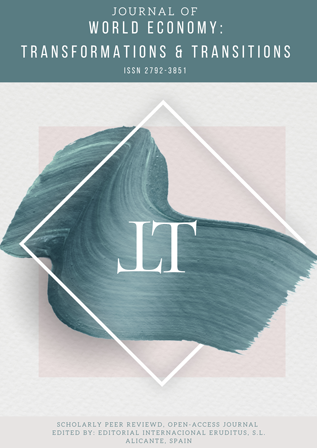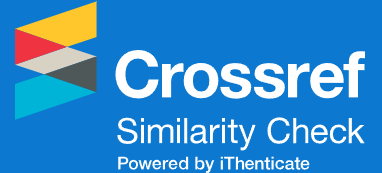ZISWaF Institutional Approach to Activate Idle Agricultural Land as a Catalyst for the Agro-Food Sector in Malaysia
DOI:
https://doi.org/10.52459/jowett25201122Keywords:
Institutional approach, ZISWaf, Agro-Food, Idle land, MalaysiaAbstract
In various efforts to strengthen the agro-food sector, development on idle land is one of the keys to achieving it. Neglect of idle land is a waste that needs to be well managed to mobilize all resources properly and produce crop yields to the maximum level. Therefore, this paper will discuss the factors that lead to the occurrence of idle land and finds a solution from a Malaysian perspective. Referring to this problem, it is seen, through the institutional approach, that it is capable of being one of the best alternatives because institutions are a set of rules that affect human economic life. Through an institutional approach, it can apply the ZISWaf management recommended by previous Islamic scholars divided into four schemes to activate idle agricultural land with proper coordination. This paper is using qualitative methods based on data and information from the literature review and then it is analysed based on a deductive approach. As a result, the ZISWaf institutional approach can realize the concept of implementing the agro-food Waqf institution to solve the issue of idle land.
CITE THIS PAPER:
Mohamed, Muhammad I.; Mohd Shafiai, Muhammad H.; Hilmi, Mohd H. (2022). "ZISWaF Institutional Approach to Activate Idle Agricultural Land as a Catalyst for the Agro-Food Sector in Malaysia" Journal of World Economy: Transformations & Transitions (JOWETT) 2(05):20. DOI: https://doi.org/10.52459/jowett25201122
Metrics
References
Ab Rahman, A. (2009). Peranan wakaf dalam pembangunan ekonomi umat Islam dan aplikasinya di Malaysia. Jurnal Syariah, 17(1), 113-152. https://ejournal.um.edu.my/index.php/JS/article/view/22746
Amin, A. Y. C. M., & Muda, M. Z. (2019). Konsep Istibdal Harta Wakaf menurut Perspektif Islam. BITARA International Journal of Civilizational Studies and Human Sciences, 2(3), 22-33. https://bitarajournal.com/index.php/bitarajournal/article/view/65/61
Anem, M. (2009). Idle Land - Development Project. http://animhosnan.blogspot.com/2009/10/development-of-idle-land.html
Azima, A. M. and Ismail, O. (2009). Challenges on Idle Agriculture Land Management – An Institutional Perspective in Malaysia. European Journal of Social Sciences, 9(1), 39-47. https://www.semanticscholar.org/paper/Challenges-on-idle-agriculture-land-management-An-Am-Ismail/f3331e85ab61fc5cbb69ff495f1822ba88143c1e
Aziz, M. R. A., Johari, F., & Yusof, M. A. (2013). Cash waqf models for financing in education. In The 5th Islamic Economic System Conference (iECONS2013). (pp. 835-842). https://www.researchgate.net/publication/257811881_CASH_WAQF_MODELS_FOR_FINANCING_IN_EDUCATION
Bello, D. A. (2009). Poverty Alleviation through Zakah and Waqf Institutions: A Case for the Muslim Ummah in Ghana [Paper presentation]. First National Muslim Summit. Al-Furqan Foundation, Radach Memorial Centre, Lamashegu, Tamale. Ghana. https://mpra.ub.uni-muenchen.de/id/eprint/23191
BH Online. (2021). Pelan Induk Wakaf Nasional dirangka. https://www.bharian.com.my/berita/nasional/2021/11/886577/pelan-induk-wakaf-nasional-dirangka.
Bondarev N., Kosinskiy P., Bondareva G. (2019). Institutional Approach to Food Security, The European Proceedings of Social & Behavioural Sciences, Future Academy, 59, 161-166. http://dx.doi.org/10.15405/epsbs.2019.04.18
Buang, A. (2001). Privatizing the rehabilitation of idle agriculture land in Malaysia feedback from the Malay folks. Pertanika Journal of Social Sciences & Humanities 9(2), 103-112. http://www.pertanika.upm.edu.my/pjtas/browse/regular-issue?article=JSSH-0137-2001
Buang. S. (2010). Malaysian Torrens System (2nd Ed.). Dewan Bahasa dan Pustaka.
Cizakca, M. (2004). Cash waqf as alternative to NBFIs bank. International Seminar on Non-bank Financial Institutions: Islamic Alternatives [Paper presentation]. Kuala Lumpur.
Dardak, R. A. (2015). Transformation of agricultural sector in Malaysia through agricultural policy. Malaysian Agricultural Research and Development Institute (MARDI), Malaysia, 7. https://ap.fftc.org.tw/article/818
El-Gari, M.A. (2004). The Qard Hassan Bank. In International Seminar on Non-bank Financial Institutions: Islamic Alternatives [Paper presentation]. Kuala Lumpur.
Farouk. H, Maiyaki, S.U & Bala, M.J. (2019). An Appraisal of the Law and Practice on Waqf in Kano State; Lessons from Egypt. International Journal of Advanced Academic Research, Arts, Humanities and Education, 5(6). https://www.ijaar.org/articles/Volume5-Number6/Arts-Humanities-Education/ijaar-ahe-v5n6-jun19-p23.pdf
Harun, N., Hamid, N.A., Salleh, K., & Bidin, A. (2017). Acquisition of waqf lands by the State Authority: A case study of land acquisition in Terengganu. Pertanika Journal of Social Sciences and Humanities, 25, 281-292. https://eprints.unisza.edu.my/1310/
Hitam, S.B. (1986). Land abandonment in Peninsular Malaysia: A case study of the Malay rubber smallholders in the district of Ulu Selangor. (Doctoral dissertation). The University of Wisconsin-Madison.
Hussein, M. A., & Thiran, M. (1982). Utilisation of idle padi lands in Negeri Sembilan. Pertanika, 5(1), 105-113. http://psasir.upm.edu.my/id/eprint/2215
Hussin, R., & Rashid, R. A. (2015). Isu-Isu Berkaitan Tanah Wakaf: Halangan Kepada Pembangunan Institusi Wakaf Pendidikan Tinggi Di Malaysia. In Sayin, B (Eds.), Wakaf Pendidikan Tinggi Di Malaysia Satu Penantian (pp.141-157). Akademi Pengajian Islam Kontemporari (ACIS), Universiti Teknologi MARA. https://www.researchgate.net/publication/303372885
Isa, Z.M., Ali, N., & Harun, R. (2011). A comparative study of waqf management in Malaysia. International Conference on Sociality and Economics Development, 10, 561-565. http://www.ipedr.com/vol10/105-S10085.pdf
Ismail, C. Z., Salim, N. J., & Hanafiah, N. J. A. (2015). Administration and management of waqf land in Malaysia: Issues and solutions. Mediterranean Journal of Social Sciences, 6(4), 613-613. http://dx.doi.org/10.5901/mjss.2015.v6n4s2p613
Israel A. (1989). Institutional Development: Incentives Performance (English). Washington, D.C.: World Bank Group. http://documents.worldbank.org/curated/en/992631468764734500/Institutional-development-incentives-to-performance
Jalil, R. A., Yaacob, A. C., Omar, I., Ridza, B. H. M., & Fadzli, S. Z. (2019). Waqf private property trust fund as property unlock initiative. IOP Conference Series: Materials Science and Engineering, 620(1), 012010. IOP Publishing. https://iopscience.iop.org/article/10.1088/1757-899X/620/1/012010
Mahamood, S. M., Ab Rahman, A., & Seman, A. C. (2018). Pembentukan Institusi Pengajian Tinggi Berteraskan Wakaf di Malaysia: Cadangan Model Pelaksanaannya: The Establishment of a Waqf-Based Higher Educational Institution in Malaysia: Proposed Model for Implementation. Jurnal Syariah, 26(1), 1-22. https://ejournal.um.edu.my/index.php/JS/article/download/11855/7854/23215
Mahmood, N. A., & Markom, R. (2014). Transformasi Institusi Pelaksana Wakaf: Kes Waqaf An-Nur Corporation. Universiti Sains Islam Malaysia. https://oarep.usim.edu.my/jspui/handle/123456789/11548
Mahmood, R. H., Mustaffha, N., Musafar Hameed, L. B., & Johari, N. (2017). Pengurusan Wakaf Di Malaysia: Isu Dan Cabaran. Proceeding of the 4th International Conference on Management and Muamalah, 2017(9). http://conference.kuis.edu.my/icomm/4th/eproceedings/IC%20005.pdf
Manaf, A. A. (2007). Keupayaan pendekatan institusi dalam menghurai punca-punca tanah pertanian terbiar di daerah Kuala Pilah, Negeri Sembilan. Jurnal Sains Sosial dan Kemanusiaan, 2(2), 25. http://journalarticle.ukm.my/1538/
Maxwell, D., Ahiadeke, C., Levin, C., Armar-Klemesu, M., Zakariah, S., & Lamptey, G.M. (1999). Alternative food-security indicators: revisiting the frequency and severity of coping strategies. Food Policy, 24(40), 411-429. https://doi.org/10.1016/S0306-9192(99)00051-2
Mohamed, M. I., & Shafiai, M. H. M. (2021a). Islamic Agricultural Economic Financing Based on Zakat, Infaq, Alms and Waqf In Empowering The Farming Community. IQTISHADUNA: Jurnal Ilmiah Ekonomi Kita, 10(1), 144-161. https://doi.org/10.46367/iqtishaduna.v10i1.334
Mohamed, M. I., & Shafiai, M. H. M. (2021b). Peranan Pentadbiran Zakat, Infaq, Sedekah dan Wakaf Dalam Sekuriti Makanan di Kalangan Golongan Rentan ketika Krisis. Jurnal Dunia Pengurusan, 3(4), 37-55. https://doi.org/10.55057/jdpg.2021.3.4.4
Mohamed, M. I., & Shafiai, M. H. M. (2022). Gabungan Kontrak Pertanian Kewangan Sosial Islam Dengan Teknologi Rantaian Blok: Pendanaan Awam Wakaf. Jurnal Dunia Pengurusan, 4(2), 51-66. https://doi.org/10.55057/jdpg.2022.4.2.4
Mohammad, M. T.S.H, Iman, A. H. M., & Omar, I. (2007). An ideal financial mechanism for the development of the waqf properties in Malaysia. Universiti Teknologi Malaysia. http://eprints.utm.my/id/eprint/2828/1/75108.pdf
Mohsin, M. I. A. (2008). Cash waqf a new financial product model aspects of shariah principles on ITS commercialization. Islamic Banking, Accounting and Finance Conference (iBAF 2008) (pp. 28-29).
Mustapha, N.H.N., Hashim, N.M.H. & Hassan, F.A. (2013). Potential of idle land for mixed vegetable and fruit farming using linear programming. Asian Journal of Empirical Research 3(4), 388-400. https://archive.aessweb.com/index.php/5004/article/view/3370
Mustapha, Z.H. & Alam, M.N. (1985). Idle agricultural land in Peninsular Malaysia: Problems and opportunities. The Malaysian Journal of Agricultural Economics 2(1), 36- 53. http://agris.upm.edu.my:8080/dspace/handle/0/1307
Noor, F.M. (2003). Agricultural law: A comparative study between Islamic law and Malaysian law, with special reference to paddy cultivation in Malaysia. (Doctoral dissertation). The University of Birmingham. https://ethos.bl.uk/OrderDetails.do?uin=uk.bl.ethos.497556
Noor Inayah Yaakub. (2014). Mencorakkan Kejayaan Wakaf Pendidikan. Utusan Online. http://www.utusan.com.my/utusan/Rencana/20140613/re_03/Mencorakkan-kejayaan-wakaf-pendidikan.
North, D. C. (1990). Institutions, Institutional Change and Economic Performance. Cambridge: Cambridge University Press. https://doi.org/10.1017/CBO9780511808678
Othman, R. (2011). Pembasmian kemiskinan: Peranan dan sumbangan institusi wakaf. In Ahmad & Z. Bahari, Pengurusan Ilmu Ekonomi dan Pembangunan Berteraskan Islam. Pulau Pinang: Universiti Sains Malaysia (USM).
Pitchay, A.A., Thaker, M.A.M.T., Mydin, A.A., Azhar, Z., & Latiff, A.R.A. (2018). Cooperative-waqf model: a proposal to develop idle waqf lands in Malaysia. ISRA International Journal of Islamic Finance, 10(2), 225-236. https://doi.org/10.1108/IJIF-07-2017-0012
Rani, A.N.H.A & Mahalle, N.D.S.S.H. (2015). Faktor Pengabaian Tanah Pertanian Dan Solusi: Kajian Kes Ladang Pertanian Lts Di Negara Brunei Darussalam. Proceeding Kuala Lumpur International Business, Economics and Law Conference, 7(3). (pp. 1-14). https://www.klibel.com/wp-content/uploads/2015/08/KLIBEL7_Econ__3-formatted.pdf
Samuels, W. (1990). Institutional economics. Edward Elgar Publishing.
Shafiai, M. H. M., Moi, M. R., & Ahmad, R. (2015). The potential of waqf in activating idle agricultural land. Jurnal Pengurusan, 44. http://ejournal.ukm.my/pengurusan/issue/view/700
Sivalingam, G. (1993). Malaysia’s Agricultural Transformation. Petaling Jaya: Pelanduk Publications.
Thaker, M.A.M.T., & Pitchay, A.A. (2018). Developing waqf land through crowdfunding waqf model (CWM): the case of Malaysia. Journal of Islamic Accounting and Business Research. 9 (3), 448-456. https://doi.org/10.1108/JIABR-05-2016-0062
Vincent, J.R. & Ali, R.M. (2010). Managing Natural Wealth: Environment and Development in Malaysia. London: Routledge.
Wakaf felda. (2020). Infografik tabung wakaf felda. Felda. https://felda.gov.my/media-home/pengumuman-program/pengumuman/tabungwakaffelda
Zainalabidin Mohamed. (2005). Model Sebuah Ekonomi Maju Dari Perspektif Islam. Mohd. Shahriza bin Sulaiman (Ed.). Kuala Lumpur: Institut Kefahaman Islam Malaysia.
Downloads
Published
Issue
Section
License
Copyright (c) 2022 Muhammad Izzat MOHAMED, Muhammad Hakimi MOHD SHAFIAI, Mohd Haziqi HILMI

This work is licensed under a Creative Commons Attribution 4.0 International License.







